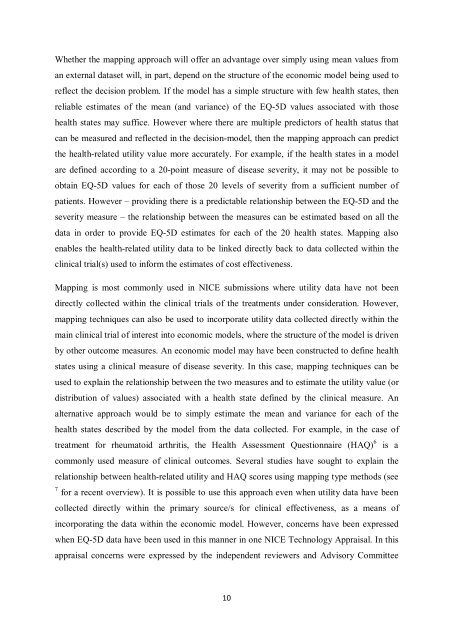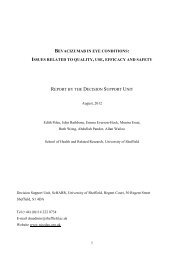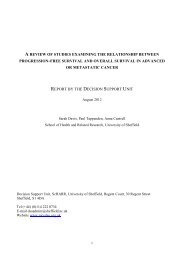the use of mapping methods to estimate health state utility values
the use of mapping methods to estimate health state utility values
the use of mapping methods to estimate health state utility values
Create successful ePaper yourself
Turn your PDF publications into a flip-book with our unique Google optimized e-Paper software.
Whe<strong>the</strong>r <strong>the</strong> <strong>mapping</strong> approach will <strong>of</strong>fer an advantage over simply using mean <strong>values</strong> from<br />
an external dataset will, in part, depend on <strong>the</strong> structure <strong>of</strong> <strong>the</strong> economic model being <strong>use</strong>d <strong>to</strong><br />
reflect <strong>the</strong> decision problem. If <strong>the</strong> model has a simple structure with few <strong>health</strong> <strong>state</strong>s, <strong>the</strong>n<br />
reliable <strong>estimate</strong>s <strong>of</strong> <strong>the</strong> mean (and variance) <strong>of</strong> <strong>the</strong> EQ-5D <strong>values</strong> associated with those<br />
<strong>health</strong> <strong>state</strong>s may suffice. However where <strong>the</strong>re are multiple predic<strong>to</strong>rs <strong>of</strong> <strong>health</strong> status that<br />
can be measured and reflected in <strong>the</strong> decision-model, <strong>the</strong>n <strong>the</strong> <strong>mapping</strong> approach can predict<br />
<strong>the</strong> <strong>health</strong>-related <strong>utility</strong> value more accurately. For example, if <strong>the</strong> <strong>health</strong> <strong>state</strong>s in a model<br />
are defined according <strong>to</strong> a 20-point measure <strong>of</strong> disease severity, it may not be possible <strong>to</strong><br />
obtain EQ-5D <strong>values</strong> for each <strong>of</strong> those 20 levels <strong>of</strong> severity from a sufficient number <strong>of</strong><br />
patients. However – providing <strong>the</strong>re is a predictable relationship between <strong>the</strong> EQ-5D and <strong>the</strong><br />
severity measure – <strong>the</strong> relationship between <strong>the</strong> measures can be <strong>estimate</strong>d based on all <strong>the</strong><br />
data in order <strong>to</strong> provide EQ-5D <strong>estimate</strong>s for each <strong>of</strong> <strong>the</strong> 20 <strong>health</strong> <strong>state</strong>s. Mapping also<br />
enables <strong>the</strong> <strong>health</strong>-related <strong>utility</strong> data <strong>to</strong> be linked directly back <strong>to</strong> data collected within <strong>the</strong><br />
clinical trial(s) <strong>use</strong>d <strong>to</strong> inform <strong>the</strong> <strong>estimate</strong>s <strong>of</strong> cost effectiveness.<br />
Mapping is most commonly <strong>use</strong>d in NICE submissions where <strong>utility</strong> data have not been<br />
directly collected within <strong>the</strong> clinical trials <strong>of</strong> <strong>the</strong> treatments under consideration. However,<br />
<strong>mapping</strong> techniques can also be <strong>use</strong>d <strong>to</strong> incorporate <strong>utility</strong> data collected directly within <strong>the</strong><br />
main clinical trial <strong>of</strong> interest in<strong>to</strong> economic models, where <strong>the</strong> structure <strong>of</strong> <strong>the</strong> model is driven<br />
by o<strong>the</strong>r outcome measures. An economic model may have been constructed <strong>to</strong> define <strong>health</strong><br />
<strong>state</strong>s using a clinical measure <strong>of</strong> disease severity. In this case, <strong>mapping</strong> techniques can be<br />
<strong>use</strong>d <strong>to</strong> explain <strong>the</strong> relationship between <strong>the</strong> two measures and <strong>to</strong> <strong>estimate</strong> <strong>the</strong> <strong>utility</strong> value (or<br />
distribution <strong>of</strong> <strong>values</strong>) associated with a <strong>health</strong> <strong>state</strong> defined by <strong>the</strong> clinical measure. An<br />
alternative approach would be <strong>to</strong> simply <strong>estimate</strong> <strong>the</strong> mean and variance for each <strong>of</strong> <strong>the</strong><br />
<strong>health</strong> <strong>state</strong>s described by <strong>the</strong> model from <strong>the</strong> data collected. For example, in <strong>the</strong> case <strong>of</strong><br />
treatment for rheuma<strong>to</strong>id arthritis, <strong>the</strong> Health Assessment Questionnaire (HAQ) 6 is a<br />
commonly <strong>use</strong>d measure <strong>of</strong> clinical outcomes. Several studies have sought <strong>to</strong> explain <strong>the</strong><br />
relationship between <strong>health</strong>-related <strong>utility</strong> and HAQ scores using <strong>mapping</strong> type <strong>methods</strong> (see<br />
7 for a recent overview). It is possible <strong>to</strong> <strong>use</strong> this approach even when <strong>utility</strong> data have been<br />
collected directly within <strong>the</strong> primary source/s for clinical effectiveness, as a means <strong>of</strong><br />
incorporating <strong>the</strong> data within <strong>the</strong> economic model. However, concerns have been expressed<br />
when EQ-5D data have been <strong>use</strong>d in this manner in one NICE Technology Appraisal. In this<br />
appraisal concerns were expressed by <strong>the</strong> independent reviewers and Advisory Committee<br />
10





